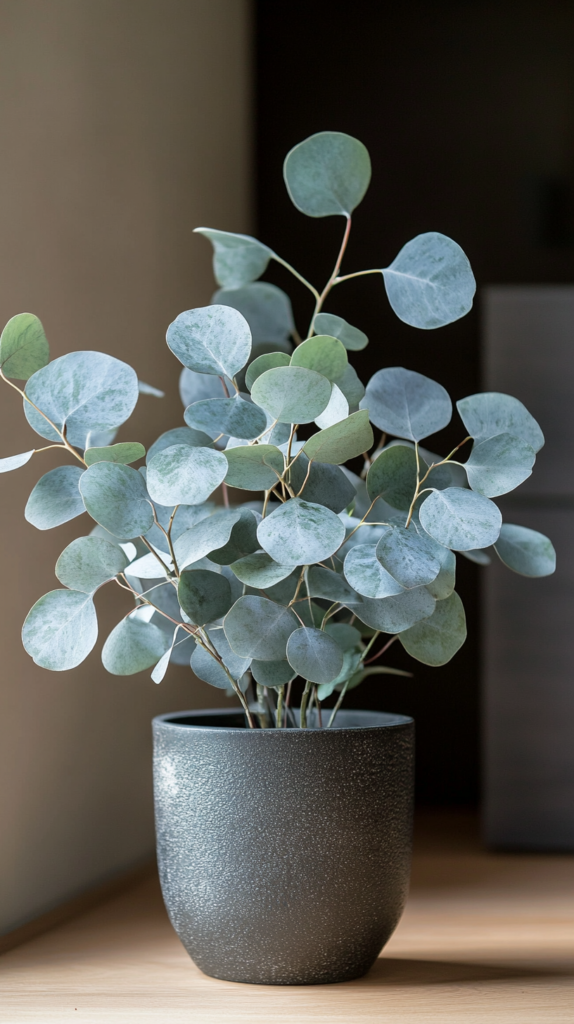Disclosure: Some links on this site are affiliate links. As Amazon Associates, we earn from qualifying purchases (at no cost to you).
Blue foliage is a rare and striking feature in the plant world. And it looks awesome, rigtht? House plants with blue leaves can add a unique and eye-catching element to your home decor.
These plants often have a subtle, silvery-blue tint that complements a variety of interior styles, from modern and minimalist to rustic and eclectic.
Here are 10 house plants with blue leaves that can bring a cool, calming touch to your indoor garden.
1. Blue Echeveria

Blue Echeveria is a stunning succulent known for its rosettes of blue-gray leaves. This plant is perfect for adding a touch of color to your indoor garden while being incredibly low-maintenance.
- Care Tips: Provide bright, indirect light and allow the soil to dry out completely between waterings. Blue Echeveria prefers well-draining soil and occasional feeding during the growing season.
2. Blue Chalksticks (Senecio serpens)

Blue Chalksticks is a succulent with narrow, finger-like blue-gray leaves. This plant adds a unique texture and color to your indoor garden.
- Care Tips: Place in bright, indirect light and water sparingly, allowing the soil to dry out between waterings. Ensure good drainage to prevent root rot.
3. Silver Sword Philodendron (Philodendron hastatum)

The Silver Sword Philodendron is known for its elongated, silvery-blue leaves. This climbing plant is perfect for adding height and a pop of color to your indoor space.
- Care Tips: Provide bright, indirect light and keep the soil consistently moist but not soggy. Support its growth with a moss pole or trellis.
4. Blue Star Fern (Phlebodium aureum)

The Blue Star Fern has fronds with a bluish tint, adding a unique touch to your plant collection. This plant is great for adding a tropical feel to your home.
- Care Tips: Place in indirect light and maintain high humidity. Keep the soil consistently moist but not waterlogged, and avoid letting it dry out completely.
5. Blue Hosta (Hosta sieboldiana ‘Elegans’)

Blue Hosta is a shade-loving plant with large, blue-green leaves. This plant is perfect for low-light areas and adds a lush, cool tone to your decor.
- Care Tips: Provide indirect light and keep the soil consistently moist. Blue Hostas thrive in cooler temperatures and high humidity.
6. Blue Fescue (Festuca glauca)

Blue Fescue is an ornamental grass with fine, needle-like blue leaves. This plant adds texture and a pop of color to your indoor garden.
- Care Tips: Place in bright, indirect light and water moderately, allowing the soil to dry out slightly between waterings. Trim back any dead foliage to keep it looking neat.
7. Blue Agave (Agave tequilana)

Blue Agave is a striking succulent with thick, blue-gray leaves. This plant is a great focal point for any indoor garden.
- Care Tips: Provide bright, direct light and allow the soil to dry out completely between waterings. Blue Agave prefers well-draining soil and infrequent watering.
8. Eucalyptus (Eucalyptus cinerea)

Eucalyptus is known for its round, silvery-blue leaves and aromatic scent. This plant adds a refreshing touch to your indoor space.
- Care Tips: Place in bright, indirect light and water when the top inch of soil is dry. Eucalyptus prefers good air circulation and occasional misting.
9. Blue Glow Agave (Agave ‘Blue Glow’)

Blue Glow Agave features rosettes of blue-green leaves with red margins. This plant is perfect for adding a dramatic touch to your indoor garden.
- Care Tips: Provide bright, direct light and well-draining soil. Water sparingly, allowing the soil to dry out completely between waterings.
10. Dudleya (Dudleya brittonii)
Dudleya, also known as the Giant Chalk Dudleya, has rosettes of blue-gray leaves covered in a fine powdery coating. This succulent adds a unique, frosty blue hue to your plant collection.
- Care Tips: Place in bright, indirect light and water sparingly, allowing the soil to dry out between waterings. Dudleya prefers well-draining soil and low humidity.
FAQ
Q: How do I maintain the blue color of my house plants? A: To maintain the blue color, provide adequate light, proper watering, and regular feeding. Ensure the plant is in the right environment for its specific needs, as different plants have different requirements.
Q: Can blue house plants survive in low light conditions? A: Some blue house plants, like the Blue Star Fern and Blue Hosta, can tolerate low light conditions. However, others may require brighter, indirect light to maintain their vibrant colors.
Q: How often should I water blue house plants? A: Watering needs vary by plant, but generally, water when the top inch of soil is dry. Always check the specific care requirements for each plant to avoid overwatering or underwatering.
Q: Do blue house plants need high humidity? A: Many blue house plants, like the Blue Star Fern and Eucalyptus, prefer high humidity. Consider using a humidity tray or regularly misting the plants to maintain the appropriate humidity levels.
Q: Are blue house plants safe for pets? A: Some blue house plants can be toxic to pets if ingested. Always check the toxicity of the plant before bringing it into a home with pets and keep potentially harmful plants out of reach.
Final Thoughts
Incorporating house plants with blue leaves into your home decor can add a unique and calming touch to any space.
From the striking Blue Echeveria to the dramatic Blue Glow Agave, these plants not only enhance your interior aesthetics but also bring a bit of nature indoors.
Remember to provide the appropriate care for each plant to ensure they thrive and maintain their stunning colors. Happy planting!












